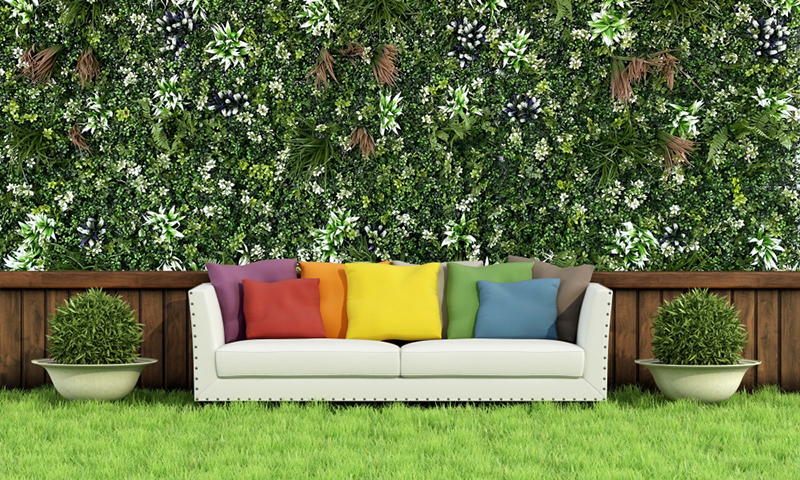Flowering Plant Arrangements for 3D Artificial Vertical Gardens: Designing Vibrant, Bloom-Filled Green Walls for Any Environment
Artificial vertical gardens offer a creative way to incorporate the beauty of flowering plants into spaces where real blooms might struggle to thrive, such as low-light interiors, high-traffic areas, or regions with extreme temperatures. By selecting designs inspired by a variety of flowering species, these gardens can provide year-round color and visual interest without the need for watering, fertilizing, or deadheading. Below are strategies for configuring artificial flowering plants to create dynamic, eye-catching 3D vertical gardens.

One of the most effective ways to create a striking artificial flowering garden is by combining blooms of different shapes and sizes. This approach mimics the natural diversity found in real gardens and adds depth to the arrangement.
Large, Showy Blooms as Focal Points: Use artificial flowers with bold, oversized petals, such as those inspired by hibiscus, peonies, or sunflowers, to draw attention. Place these designs at eye level or in central positions to serve as the main attraction of the garden.
Small, Clustered Flowers for Texture and Fullness: Incorporate artificial plants with tiny, delicate blooms, like those resembling baby’s breath, lavender, or Queen Anne’s lace, to fill gaps and add a sense of abundance. These clusters create a soft, airy look that contrasts with larger flowers.
Spiky or Tubular Flowers for Drama: Introduce artificial flowers with elongated, pointed petals, such as those mimicking snapdragons, foxgloves, or lupines, to add vertical interest. These designs work well in upper sections of the garden or along the edges to create a sense of movement.
Color is a powerful tool in garden design, and artificial flowering plants allow for precise control over hue and tone. By selecting complementary or contrasting colors, you can create a visually appealing display that enhances the overall aesthetic of the space.
Monochromatic Schemes for Elegance: Stick to a single color family, such as shades of pink, purple, or yellow, to create a cohesive and sophisticated look. Use artificial flowers in varying intensities, from pale pastels to deep, saturated tones, to add depth without overwhelming the arrangement.
Complementary Colors for Vibrancy: Pair flowers in opposing hues on the color wheel, such as purple and yellow, blue and orange, or red and green, to create a lively and energetic display. These combinations work well in areas where you want to make a bold statement, such as entryways or living rooms.
Neutral Accents for Balance: Incorporate artificial flowers in white, cream, or beige, like those resembling gardenias, daisies, or roses, to soften bright color schemes and add a touch of calm. These neutral blooms serve as a bridge between bolder colors and prevent the garden from looking too busy.
While flowers are the stars of the show, foliage plays a crucial supporting role in creating a realistic and visually appealing artificial garden. By mixing flowering plants with different types of leaves, you can mimic the look of a thriving, natural ecosystem.
Broad, Green Leaves as a Backdrop: Use artificial plants with large, lush leaves, such as those inspired by hostas, elephant ears, or caladiums, to provide a rich green foundation for the flowers. These designs create a sense of fullness and help the blooms stand out.
Variegated Foliage for Visual Interest: Incorporate artificial plants with leaves that feature streaks, spots, or edges of white, cream, or yellow, like those mimicking coleus or calathea, to add texture and break up solid blocks of green. These patterns complement the flowers and create a more dynamic display.
Fine, Fern-Like Foliage for Softness: Introduce artificial plants with delicate, lacy leaves, such as those resembling asparagus ferns or maidenhair ferns, to add a sense of airiness and lightness. These designs work well as fillers between larger flowers and foliage plants.
In natural gardens, flowers grow at different heights, creating a layered effect that adds depth and dimension. Artificial gardens can replicate this strategy by arranging flowers in a way that mimics their natural growth habits.
Foreground Flowers for Detail and Intimacy: Place shorter artificial flowers, such as those resembling pansies, violas, or primroses, in the front of the arrangement. These designs draw viewers in and add a sense of closeness to the garden.
Middle-Ground Flowers for Volume and Balance: Use medium-height artificial flowers, like those inspired by roses, daisies, or marigolds, to fill out the middle sections of the garden. These blooms create a sense of fullness and connect the foreground to the background.
Background Flowers for Height and Structure: Incorporate taller artificial flowers, such as those resembling delphiniums, lilies, or gladioli, in the back of the arrangement. These designs provide a sense of scale and frame the entire garden, making it feel more immersive.
By focusing on flower shape variety, color harmony, foliage pairing, and layered arrangements, artificial flowering plants can transform 3D vertical gardens into vibrant, low-maintenance displays. Their durability and adaptability make them ideal for any space, ensuring year-round beauty without the need for sunlight, water, or ongoing care.
Contact: Amy
Phone: 86-15311787313
E-mail: info@foszmac.com
Whatsapp:86-15311787313
Add: Fengtai District, Dacheng Road, No.24 Building, Room 203, Beijing, China